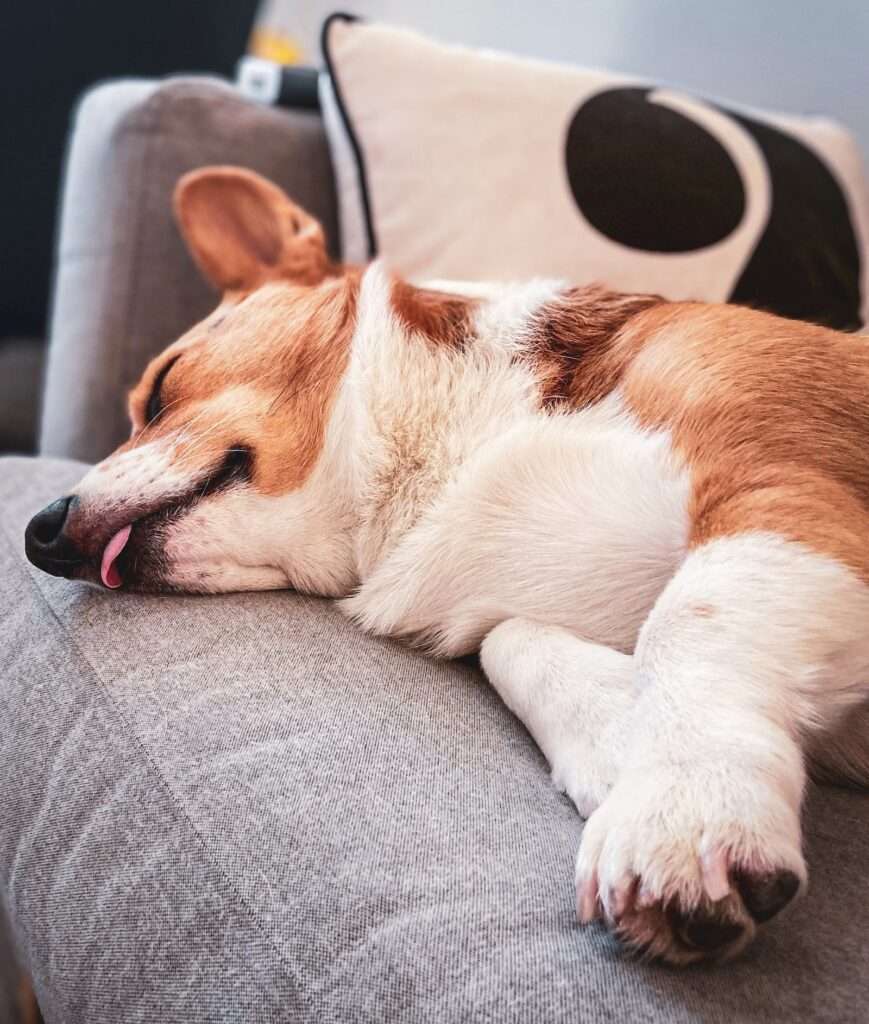Why Does My Dog Move from Spot to Spot While Sleeping? Exploring the Strange Phenomenon
Discover the captivating truth behind why your furry companion can’t seem to settle in one place while snoozing. In this all-encompassing guide, we unravel the perplexing mystery of why dogs move from spot to spot while sleeping.
Prepare to be amazed as we uncover the secrets hidden within their restless slumber. From instinctual behaviors to environmental influences, we leave no stone unturned in our quest to understand this fascinating canine phenomenon.
So, join us on this enthralling journey as we answer the burning question: “Why does my dog move from spot to spot while sleeping?” Get ready to unlock the door to a deeper understanding of your beloved pet’s sleep habits.
Understanding Canine Sleep Patterns

Just like humans, dogs experience various sleep stages that play a vital role in their overall health and happiness. While they may not be able to communicate their dreams to us, their sleep patterns offer valuable insights into their well-being. To understand why dogs move from spot to spot while sleeping, we must first grasp the basics of their sleep cycle.
Dogs go through different stages of sleep, which include both deep sleep and REM sleep, just like humans. During deep sleep, their muscles relax, and their breathing slows down, allowing for physical recovery and restoration. REM sleep, on the other hand, is associated with dreaming and increased brain activity. These sleep stages alternate throughout the night, creating a dynamic sleep pattern for our furry companions.
While dogs’ sleep patterns may bear some similarities to our own, there are also intriguing differences. For instance, dogs tend to have shorter sleep cycles compared to humans. Additionally, their REM sleep percentage is higher, suggesting that they may experience more vivid dreams. By understanding these sleep patterns, we can start unraveling the mystery of why our dogs restlessly move from one spot to another during slumber.
Now that we have a foundation in canine sleep patterns, let’s delve deeper into the reasons behind their restless behavior while sleeping.
The Reasons Behind Canine Restlessness While Sleeping
Have you ever observed your furry friend seemingly on a quest for the perfect sleeping spot, shifting from place to place before settling down? Rest assured, there are valid reasons behind this intriguing behavior. From their innate instincts to their physical needs, multiple factors contribute to our dogs’ restlessness while they slumber. Let’s explore these reasons together and gain a deeper understanding of our canine companions.
- In the wild, dogs are territorial animals, instinctively seeking out safe and secure spaces for rest. Moving from spot to spot while sleeping mimics their ancestral behavior, where they would change locations to ensure their safety and protect themselves from potential threats. This instinctual behavior, deeply ingrained in their DNA, manifests itself even in our domesticated companions.
- Just like humans, dogs also strive to find the ideal sleeping temperature. Our canine friends possess unique physiological features that affect their thermoregulation. They may move from spot to spot while sleeping to seek out cooler areas during hot weather or warmer spots during colder seasons. By adjusting their sleeping locations, dogs can effectively regulate their body temperature and ensure their comfort throughout the night.
- Sometimes, restlessness during sleep can indicate underlying physical discomfort or pain in our beloved pets. Dogs may change positions or move to different spots in an attempt to alleviate discomfort caused by joint issues, muscle soreness, or other medical conditions. If you notice persistent restlessness during sleep or any signs of discomfort, it’s essential to consult with your veterinarian to identify and address any potential underlying health concerns.
- Have you ever watched your dog’s paws twitching, tail wagging, or even heard them emit soft barks while they sleep? These adorable displays often indicate that our furry friends are dreaming during their active sleep, also known as REM sleep. Just like humans, dogs experience vivid dreams during this stage. The movements and vocalizations observed while they slumber are their responses to the dreams they’re experiencing, causing them to change positions and locations.
Environmental Factors that Influence Sleep Behavior

While understanding the internal factors behind dogs’ restless sleep behavior is crucial, we must also consider the external factors that can influence their slumber. Environmental conditions play a significant role in our furry friends’ sleep quality. From noise levels to lighting conditions and the comfort of their sleeping space, these factors can greatly impact their ability to rest peacefully. Let’s explore these environmental factors and their effects on our dogs’ sleep.
- Dogs have incredibly acute hearing, allowing them to detect sounds that may go unnoticed by human ears. Noisy environments, such as loud traffic, construction work, or even household appliances, can disturb their sleep and prompt them to change sleeping spots. By providing a quiet and calm environment for your dog’s rest, you can help minimize disturbances and ensure they have a peaceful sleep experience.
- Lighting conditions also play a role in dogs’ sleep quality. While dogs have different visual capabilities compared to humans, they are still sensitive to light. Excessive brightness or exposure to harsh lighting can disrupt their sleep patterns. Creating a dark and soothing environment during bedtime can help promote better sleep quality for your furry friend.
- The comfort of their sleeping space and the availability of cozy spots can significantly impact our dogs’ sleep behavior. Just like us, they have preferences when it comes to sleeping surfaces and locations. Some may prefer the coolness of a tiled floor, while others may seek the comfort of a soft bed or a favorite cushion. Ensuring that your dog has access to a comfortable and inviting sleeping area can contribute to their overall sleep satisfaction.
By understanding the influence of these environmental factors on our dogs’ sleep behavior, we can make informed decisions and create an optimal sleep environment for our furry companions.
Behavioral and Psychological Factors
Beyond the physical and environmental factors, our dogs’ behavior and psychological well-being also play a significant role in their sleep patterns. Canine instincts, past experiences, and emotional states can contribute to their restlessness during sleep. By understanding these behavioral and psychological factors, we can gain a deeper insight into our furry friends’ sleep habits.
- Dogs have innate instincts and habits that can manifest during sleep. One such behavior is nesting—creating a safe and secure sleeping area. You may notice your dog circling, pawing at their bedding, or rearranging their sleeping spot before settling down. This nesting behavior is rooted in their ancestral instincts to create a cozy and protective sleeping environment. Additionally, dogs may engage in scent marking during sleep as a way to establish ownership and mark their territory.
- Anxiety and stress can also influence our dogs’ sleep patterns. Separation anxiety, fear, or even past traumatic experiences can lead to restless sleep. Dogs experiencing these emotions may exhibit increased movement, whining, or even night terrors during their slumber. Recognizing signs of anxiety or stress during sleep is crucial for addressing their emotional well-being and ensuring they can relax and recharge through restful sleep.
- Past experiences can leave a lasting impact on our dogs’ sleep habits. Rescue dogs or those with traumatic backgrounds may exhibit unique sleep behaviors as a result of their past experiences. It’s important to provide a safe and nurturing environment for these dogs, helping them build trust and providing the necessary support to overcome any sleep-related challenges that may arise.
Observing and Responding to Your Dog’s Sleep Habits
As responsible pet owners, it is our duty to closely observe and respond to our dogs’ sleep habits. By paying attention to their sleeping patterns and behaviors, we can better understand their individual needs and ensure their well-being. Let’s explore some essential tips for observing and responding to your dog’s sleep habits.
- Monitoring your dog’s sleep behavior is key to detecting any changes or potential issues. Keep a watchful eye on their sleep patterns, duration, and any restlessness or disturbances they may exhibit during slumber. This information can help you identify any underlying health concerns or environmental factors that may be impacting their sleep quality.
- A sleep diary can be a valuable tool for tracking your dog’s sleep habits. Create a simple journal or use a dedicated app to record details such as sleep duration, positions, movements, and any notable behaviors observed during sleep. Over time, this sleep diary will provide you with valuable insights into your dog’s sleep patterns, allowing you to make informed decisions about their sleep environment and overall well-being.
- While many sleep disturbances in dogs can be resolved through observation and minor adjustments, there may be instances where professional advice is warranted. If you notice persistent or severe sleep disruptions, unusual behaviors, or signs of pain or discomfort during sleep, it’s crucial to consult with your veterinarian or a certified animal behaviorist. These professionals can provide guidance and recommendations tailored to your dog’s specific needs.
By closely observing your dog’s sleep habits and seeking appropriate guidance when needed, you can ensure that they enjoy restful and rejuvenating sleep.
Promoting Restful Sleep for Your Canine Companion
Now that we have explored the various factors influencing our dogs’ sleep behaviors, let’s focus on how we can promote restful sleep for our beloved canine companions. By implementing simple strategies and providing a conducive sleep environment, we can help our furry friends achieve the rejuvenating sleep they need for their overall well-being.
- Creating a consistent sleep routine is essential for dogs. Just like us, they thrive on structure and predictability. Establish a regular bedtime and wake-up time, and try to maintain consistency even on weekends. This routine will help regulate their internal clock, allowing them to settle into a restful sleep more easily.
- Comfort is key when it comes to promoting restful sleep for your dog. Choose a suitable bedding option that caters to their preferences, whether it’s a soft bed, a cozy blanket, or a cooling mat. Consider their size, age, and any specific needs they may have, such as orthopedic support for older dogs. Ensure their sleeping area is clean, quiet, and free from any potential disturbances.
- Minimizing environmental factors that can disrupt sleep is crucial. Keep noise levels low during bedtime, and consider using white noise machines or calming music to drown out any disruptive sounds. Optimize the lighting conditions in their sleeping area by providing a dimly lit or dark space, as this promotes a more peaceful sleep environment.
By implementing these strategies and creating a comfortable sleep haven, you can greatly contribute to your dog’s restful slumber and overall quality of life.
Conclusion
In this comprehensive exploration of our dogs’ sleep habits, we have uncovered the fascinating reasons behind their restless behavior and the factors that influence their sleep patterns. From their instinctual need for protection to their quest for comfort, our canine companions navigate a complex world of slumber. By understanding their unique sleep patterns and addressing their individual needs, we can ensure that our furry friends enjoy the restful sleep they deserve.
As responsible pet owners, let us commit to observing and responding to our dogs’ sleep habits with care and attention. By creating a sleep-supportive environment, maintaining a consistent routine, and seeking professional advice when needed, we can promote optimal sleep for our canine companions and enhance their overall well-being.
Remember, our dogs bring us immeasurable joy and unconditional love. By nurturing their sleep health, we contribute to their happiness and longevity. Let’s continue to deepen our understanding of our furry friends, celebrating their unique behaviors, and ensuring they enjoy a lifetime of peaceful slumber. Sweet dreams to our beloved canine companions!
Frequently Asked Questions
Q: Why does my dog move from spot to spot while sleeping?
A: Dogs may move from spot to spot while sleeping due to various reasons. It could be their instinctual nesting behavior, an attempt to find a more comfortable position, or a response to environmental factors. Observing their sleep habits and creating a conducive sleep environment can help address any restlessness.
Q: Should I be concerned if my dog constantly shifts sleeping spots?
A: Occasional movement during sleep is usually normal for dogs. However, if your dog is excessively restless or shows signs of discomfort, it’s worth consulting with a veterinarian to rule out any underlying health issues or discomfort that may be affecting their sleep.
Q: How can I promote restful sleep for my dog?
A: To promote restful sleep, establish a consistent sleep routine, provide a comfortable sleeping area, and minimize environmental disturbances. Creating a calm and relaxing sleep environment tailored to your dog’s needs can contribute to their overall sleep satisfaction.
Q: My dog exhibits anxiety or restlessness during sleep. What can I do?
A: Anxiety or restlessness during sleep can be indicative of underlying stress or emotional issues. Consider consulting with a veterinarian or certified animal behaviorist to address any anxiety-related concerns. They can provide guidance on techniques or therapies to help alleviate your dog’s anxiety and promote better sleep.
Q: Can certain health conditions contribute to my dog’s restless sleep?
A: Yes, certain health conditions such as arthritis, allergies, or discomfort from injuries can cause dogs to shift sleeping spots frequently. If you suspect an underlying health issue, consult with your veterinarian to address and manage the condition, which may help improve your dog’s sleep quality.
Q: What are some signs that my dog is not getting enough quality sleep?
A: Signs that your dog may not be getting enough quality sleep include excessive daytime sleepiness, irritability, difficulty staying awake, and lack of energy during activities. If you notice persistent changes in your dog’s sleep patterns or behavior, it’s advisable to consult with a veterinarian for further evaluation.
Q: How long should dogs sleep in a day?
A: The amount of sleep dogs need can vary based on their age, breed, and individual characteristics. On average, adult dogs sleep for about 12 to 14 hours a day, while puppies and senior dogs may require more sleep. However, it’s essential to monitor your dog’s overall behavior and energy levels to ensure they are getting adequate rest.
Q: Are there any specific sleep positions I should watch out for?
A: Dogs have different preferred sleep positions, and it’s normal for them to change positions during sleep. However, if your dog consistently avoids certain positions, shows signs of discomfort, or has difficulty settling into a comfortable sleep position, it’s best to consult with a veterinarian to rule out any potential health issues.
Q: When should I seek professional advice regarding my dog’s sleep behavior?
A: If your dog’s sleep disturbances persist, worsen, or are accompanied by other concerning symptoms such as excessive panting, whimpering, or difficulty breathing, it’s recommended to seek professional advice from a veterinarian. They can evaluate your dog’s overall health and provide appropriate guidance and treatment if necessary.
Please note that while these answers provide general information, it’s important to consult with a qualified veterinarian for personalized advice regarding your dog’s specific needs and sleep behavior.
References
- Casper. (n.d.). The Ultimate Guide to Dog Sleeping Positions. Retrieved from https://casper.com/blog/dog-sleeping-positions/
- Psychology Today. (n.d.). Can Dogs Have Sleep Disorders? Retrieved from https://www.psychologytoday.com/us/blog/canine-corner/202305/can-dogs-have-sleep-disorders
- Endura Flap. (n.d.). What Your Dog’s Sleeping Habits Mean. Retrieved from https://enduraflap.com/blogs/pet-doors/what-your-dogs-sleeping-habits-mean
- Purina. (n.d.). Why Do Dogs Sleep So Much? Retrieved from https://www.purina.co.uk/articles/dogs/behaviour/common-questions/why-do-dogs-sleep-so-much




